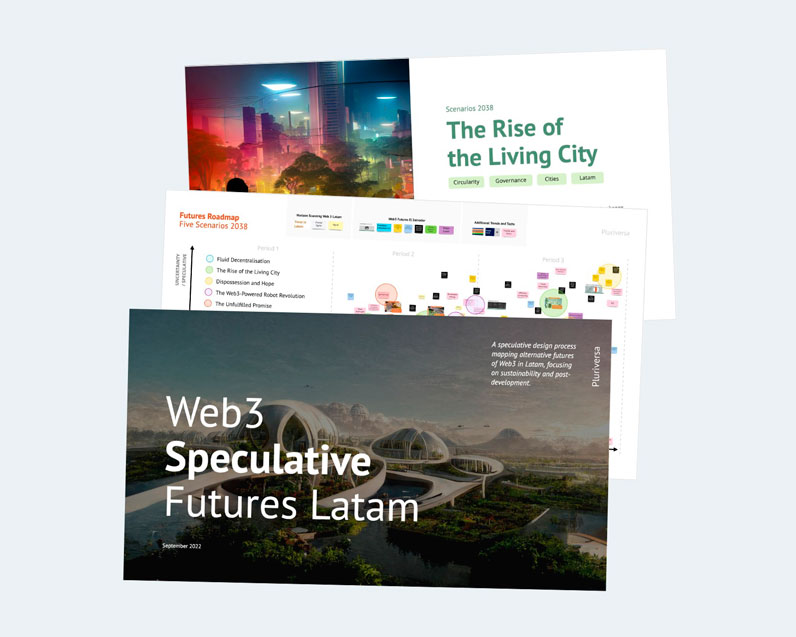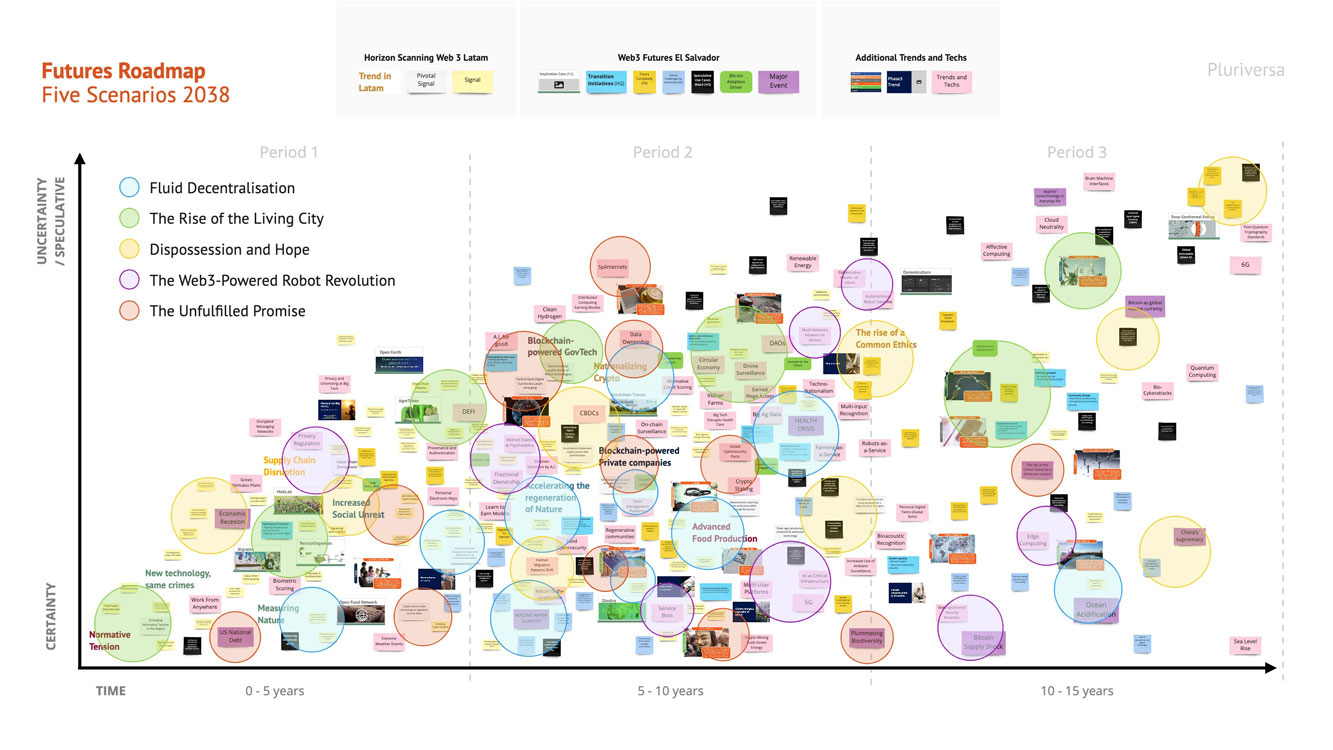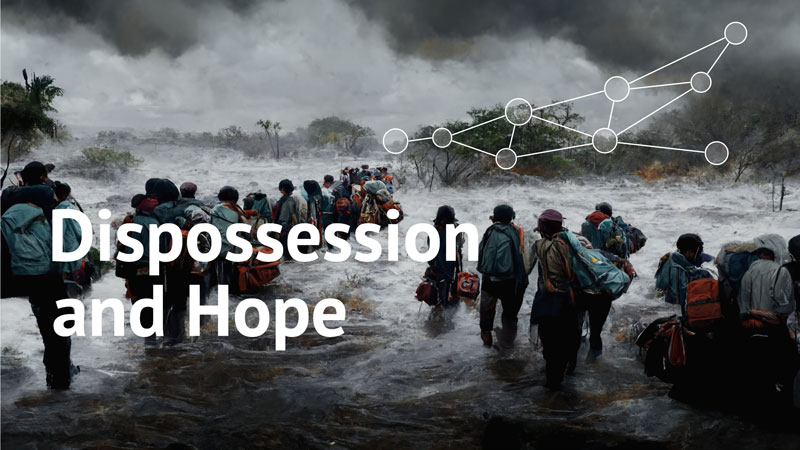Our actions
Speculative futures for postdevelopment and sustainability using Blockchain technologies
In brief:
Speculating about the future requires both analytical and creative skills. On the one hand, method and discipline to understand and connect the signals correctly; on the other, intuition and magic to deal with ambiguity and be provocative.
This project aims to provide different speculative scenarios of Web3 and Blockchain, discuss their significant impacts, and make recommendations for public policy toward developing this technology for the region’s welfare.
We hope this effort will support readers in creating their strategies for collaboration and engagement toward the pluralistic development of Latin America, with its people, visions, and extensive biodiversity at the center of their considerations.
- UK Foreign, Commonwealth & Development Office – FCDO
- Frontier Technologies
Sector:
Web3, Bitcoin, Blockchain
Location:
Latin America
Year:
2022

The question about sustainability is inextricably connected to the question of the development model our society needs / wants / dreams. Due to this, our focus is on sustainable environmental futures under the current and future climate crises and how Web3 capabilities can be relevant to achieve them in Latin America. We travel 15 years into the future to the year 2038 to develop our speculative scenarios.
Five speculative scenarios for 2038
Thanks to the mapping we carried out, we could imagine five trajectories of relevant events for the future of Latin America. Some trajectories overlap and use common elements, although with different approaches in each case. To summarise the content of each scenario, they would be:
- Rurality and water
- The city and circularity
- The continent and migration
- Robots and the Web3
- Money and collapse
We cannot think of Web3 cases as mere apps that operate in the same political framework, in the same infrastructures, or the same people’s daily lives. We must imagine a world radically transformed in its policies, infrastructures, and everyday life, in the same way that the world changed with electricity or automobiles.
Scenario 1: Fluid Decentralization
Colombia confronted massive droughts thanks to international cooperation and Web3 technologies. This last was crucial to help coordinate the population and solve the issue through decentralized cooperatives. The result was new forms of governance recognized by the government as key agents to fight climate change and protect the territory. New forms of decentralized science and protecting nature emerged, as well as essential changes in how rural communities organized themselves. Now, thanks to this new model, international cooperation revolves transparently around the causes being supported. However, other challenges exist, like new forms of territorial violence.
Scenario 2: The Rise of the Living City
Relational cities in Latin America are helping confront climate change and establish a new form of relating with the environment. This was all possible thanks to a smart contract signed in Lima by some of the region’s megacities. These megacities established a ‘proof-of-circularity’ protocol, moving away from linear economies and towards circular ones. With the help of international cooperation, new forms of governance emerged where citizens had a direct say on important local matters. Similarly, new forms of decentralized finance allowed people to invest in different initiatives, facilitating the flourishing of common goods. However, the implementation of so much technology is not risk-free.
Scenario 3: Dispossession and Hope
Latin America is experiencing an unprecedented massive migration due to extreme temperatures and the deterioration of the quality of life. People are desperate and armed groups are taking advantage of the region’s vulnerability to send large groups via the Pacific ocean to pursue the ‘Asian Dream.’ The world is under Asian dominance after the crisis of capitalism, and Latin America is experimenting with decentralized forms of governance to confront the situation. Despite the struggles, new solutions using Web3 technologies are emerging, and a new form of regional identity is taking shape.
Scenario 4: The Web3-Powered Robot Revolution
2023 became known as the year of ‘the great shortage’. In time, countries moved away from globalization and relocated entire industries back home. Countries in Latin America established their own data centers using a decentralized Web3-based cloud. These allowed Web3 robots to become functional, and life began to change drastically. However, the fundamental social transformation occurred when people were able to create their own legally binding avatars in the Metaverse. What could go wrong when robots and avatars trade at the speed of light?
Scenario 5: The Unfulfilled Promise
At the beginning of the 30s, the US was highly in debt, and a new economic depression emerged. An unprecedented social upheaval occurred, and people started looking for alternative ways to maintain their purchasing power. Cryptocurrencies were one of the most popular alternatives for risk-takers. The massive crypto adoption also led to crypto fiscal paradises and several decentralized networks competing, where Central Bank Digital Currencies (CBDCs) are relevant but still dangerous.
Bottom line
Based on the speculative scenarios, we make general recommendations for developing policies and initiatives for the development of Web3 for Latin America’s plural, economic, political, financial, environmental, and legal well-being. We hope this research and our conclusions can help shape Web3 toward desirable futures.










